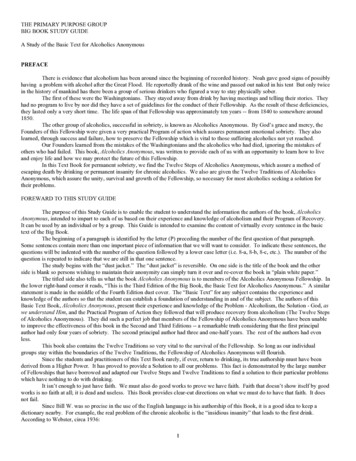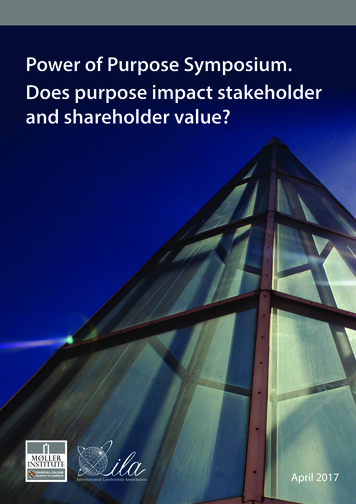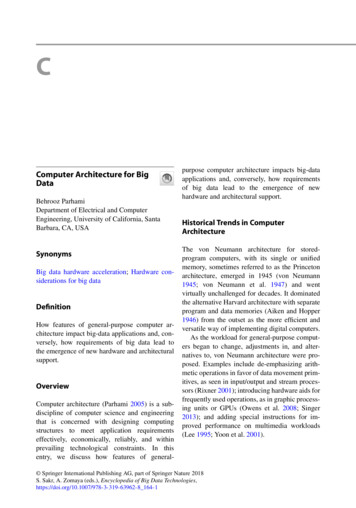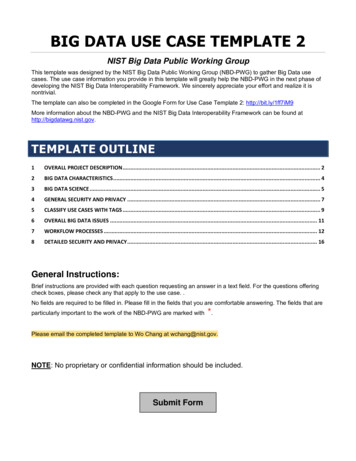
Transcription
THE PRIMARY PURPOSE GROUPBIG BOOK STUDY GUIDEA Study of the Basic Text for Alcoholics AnonymousPREFACEThere is evidence that alcoholism has been around since the beginning of recorded history. Noah gave good signs of possiblyhaving a problem with alcohol after the Great Flood. He reportedly drank of the wine and passed out naked in his tent But only twicein the history of mankind has there been a group of serious drinkers who figured a way to stay physically sober.The first of these were the Washingtonians. They stayed away from drink by having meetings and telling their stories. Theyhad no program to live by nor did they have a set of guidelines for the conduct of their Fellowship. As the result of these deficiencies,they lasted only a very short time. The life span of that Fellowship was approximately ten years -- from 1840 to somewhere around1850.The other group of alcoholics, successful in sobriety, is known as Alcoholics Anonymous. By God’s grace and mercy, theFounders of this Fellowship were given a very practical Program of action which assures permanent emotional sobriety. They alsolearned, through success and failure, how to preserve the Fellowship which is vital to those suffering alcoholics not yet reached.Our Founders learned from the mistakes of the Washingtonians and the alcoholics who had died, ignoring the mistakes ofothers who had failed. This book, Alcoholics Anonymous, was written to provide each of us with an opportunity to learn how to liveand enjoy life and how we may protect the future of this Fellowship.In this Text Book for permanent sobriety, we find the Twelve Steps of Alcoholics Anonymous, which assure a method ofescaping death by drinking or permanent insanity for chronic alcoholics. We also are given the Twelve Traditions of AlcoholicsAnonymous, which assure the unity, survival and growth of the Fellowship, so necessary for most alcoholics seeking a solution fortheir problems.FOREWARD TO THIS STUDY GUIDEThe purpose of this Study Guide is to enable the student to understand the information the authors of the book, AlcoholicsAnonymous, intended to impart to each of us based on their experience and knowledge of alcoholism and their Program of Recovery.It can be used by an individual or by a group. This Guide is intended to examine the content of virtually every sentence in the basictext of the Big Book.The beginning of a paragraph is identified by the letter (P) preceding the number of the first question of that paragraph.Some sentences contain more than one important piece of information that we will want to consider. To indicate these sentences, thequestions will be indented with the number of the question followed by a lower case letter (i.e. 8-a, 8-b, 8-c, etc.). The number of thequestion is repeated to indicate that we are still in that one sentence.The study begins with the “dust jacket.” The “dust jacket” is reversible. On one side is the title of the book and the otherside is blank so persons wishing to maintain their anonymity can simply turn it over and re-cover the book in “plain white paper.”The titled side also tells us what the book Alcoholics Anonymous is to members of the Alcoholics Anonymous Fellowship. Inthe lower right-hand corner it reads, “This is the Third Edition of the Big Book, the Basic Text for Alcoholics Anonymous.” A similarstatement is made in the middle of the Fourth Edition dust cover. The “Basic Text” for any subject contains the experience andknowledge of the authors so that the student can establish a foundation of understanding in and of the subject. The authors of thisBasic Text Book, Alcoholics Anonymous, present their experience and knowledge of the Problem - Alcoholism, the Solution - God, aswe understand Him, and the Practical Program of Action they followed that will produce recovery from alcoholism (The Twelve Stepsof Alcoholics Anonymous). They did such a perfect job that members of the Fellowship of Alcoholics Anonymous have been unableto improve the effectiveness of this book in the Second and Third Editions -- a remarkable truth considering that the first principalauthor had only four years of sobriety. The second principal author had three and one-half years. The rest of the authors had evenless.This book also contains the Twelve Traditions so very vital to the survival of the Fellowship. So long as our individualgroups stay within the boundaries of the Twelve Traditions, the Fellowship of Alcoholics Anonymous will flourish.Since the students and practitioners of this Text Book rarely, if ever, return to drinking, its true authorship must have beenderived from a Higher Power. It has proved to provide a Solution to all our problems. This fact is demonstrated by the large numberof Fellowships that have borrowed and adapted our Twelve Steps and Twelve Traditions to find a solution to their particular problemswhich have nothing to do with drinking.It isn’t enough to just have faith. We must also do good works to prove we have faith. Faith that doesn’t show itself by goodworks is no faith at all; it is dead and useless. This Book provides clear-cut directions on what we must do to have that faith. It doesnot fail.Since Bill W. was so precise in the use of the English language in his authorship of this Book, it is a good idea to keep adictionary nearby. For example, the real problem of the chronic alcoholic is the “insidious insanity” that leads to the first drink.According to Webster, circa 1936:1
insidious awaiting a chance to ensnare.ensnare to lure, entice or capture.insanity - state of being insane, unsoundness of mind, derangement of mind esp. without recognition ofone’s illness.ACKNOWLEDGEMENTSCredit for this Study Guide must begin with Bill W. and Dr. Bob. Their determination to stay sober led them to search forand go to alcoholics who were suffering from alcoholism. From their efforts, and the efforts of those they had helped, came the FirstOne Hundred sober men and women. From that Fellowship came a Program which would be known as “Alcoholics Anonymous.”Because of the two “Arkansas Travelers,” Joe McQ. and Charlie P., their “The Big Book Comes Alive” meetings and theirfour day “Big Book Seminars” at which they shared their knowledge and experience of our Program, came our first understanding ofthe material in the Basic Text for Alcoholics Anonymous. This created a thirst for an even greater knowledge of the vital informationcontained in the Big Book. This desire gave birth to The Primary Purpose Group of Alcoholics Anonymous of Dallas, Texas, inJanuary, 1988. So, to all the present and past members of this Group goes thanks for their interest and participation.We also must give thanks to a great lady, Londa, who took time from her job and family to correct some errors that weremade by the alcoholics who prepared this Study Guide.But most of all, we give our thanks to our Heavenly Father for revealing to the First One Hundred the secret of this Programwhich promises alcoholics and many others how to have a primary purpose and learn how to enjoy a life that is happy, joyous andfree!PREFACE TO FOURTH EDITION(Page xi)(P)1. Which Edition is this one?2-a. When was it first published?2-b. How many copies went into circulation between the First and Second Editions?4-a. When was the Second Edition published?4-b. How many copies of the Second Edition were sold or distributed?6-a. When was the Third Edition published?6-b. How many copies went were put into circulation?(P)8-a. What has this book become?8-b. Why?8-c. Has there been a desire to make any changes in it?11. Have there been any significant changes in the first 164 pages?12-a. What has been kept totally intact?12-b. Dr. Silkworth was what to our society?(P)14. What three things were added to the Second Edition?15-a. What was the chief change to the Second Edition?15-b. Why were these changes made?17. What else is said about the Second Edition? (rest of paragraph)(Page xii)(P) 1. What part of the Big Book was left unchanged in the Third Edition?2. What changes were made? (2 sentences)2
(P)3-a. What has been added to the Fourth Edition?3-b. What has been revised?5. How have the “Story Sections” been revised? (rest of paragraph)(P)6-a. What is the nickname for the Basic Text, Alcoholics Anonymous?6-b. Why have changes been made in the Big Book?6-c. And, hopefully, to accomplish what?9. What is our hope for a person with a drinking problem as he reads this book?FOREWARD TO FIRST EDITION(Page xiii)(P)1-a. Who authored this book?1-b. How many were there?1-c. What had happened to them?4. Why did they go to the trouble to write this book?5. If we have a drinking problem and study this book, what else will we need?6. What do we think can be accomplished by reading this book?7. What is it that many do not comprehend?8. Do we believe this book is for alcoholics only?(P)9. Why was it important for the authors of this book to remain anonymous?10. Were the authors of this book “bums”?11. What is our alcoholic work?(P)12-a. What are we told to do if we write or speak publicly?12-b. We are told to identify ourselves as what?(P)14. Are we serious about anonymity at the level of the press?(P)15. Are we an organization?(Page xiv)1. How much does it cost for membership in A.A.?2. What is the only requirement for membership?3-a. With whom are we affiliated?3-b. Who or what are we against?5. What is our single simple wish?(P)6. For those who read this book, who do we want to hear from?7. What is it we really want to do?3
(P)8. Who else would we like to hear from?FOREWAORD TO SECOND EDITIONThe “Foreword to Second Edition” provides a brief history of the first 20 years of the creation of Alcoholics Anonymous. Inthis Foreword, Bill W. tells how, through Dr. Silkworth and the Oxford Group, he found a solution to his alcoholism. He tells how hewas able to stay sober by trying to help other alcoholics. He recounts how his business venture in Akron failed and why he sodesperately felt the need to find another alcoholic to talk with. This need led to his meeting with Dr. Bob, who had tried to find a wayto stay sober but had failed completely. Their meeting led to the two of them believing they could stay sober if they worked together.From their combined efforts to protect their sobriety, by searching out and going to suffering alcoholics, came a fellowship of soberalcoholics from whom came the lifesaving Program of Alcoholics Anonymous, which is the content of this book.They tell how they found the acceptance and endorsement of some of the leading citizens of our country. We learn of someof the favorable publicity this little group of sober alcoholics received from some very influential news sources which led to a rapidgrowth of the Fellowship.We are given a glance at the recognition of some of the problems our Founders faced and how they successfully developed aset of guidelines for our conduct within our respective groups and within the Fellowship itself -- the Twelve Traditions of AlcoholicsAnonymous.We learn how successful those seeking help were when the only guide we had was this Big Book, the Basic Text for ourFellowship. It is very obvious that we are not doing nearly as well today because of the emphasis on “meetings” rather than the“Program”- (These are the steps we took, which are suggested as a program of recovery).It concludes by telling us of the hope behind the writing of this Book.(Page xv)(P)1. From the First Edition to the publication of this Edition, what had taken place?2. What was the hope of the earliest printing?3. Had this hope become a reality by 1955?(P)4. How many years passed before the Second Edition was published?5-a. During that period of time, how many A.A. groups had formed?5-b. How many alcoholics had recovered?7. How far had A.A. spread during these sixteen years? (3 sentences)8. What did many of our friends see ahead for our Fellowship?(P)9-a. Where was the first group formed?9-b. When was the first group formed?9-c. Who were the principals of the first group?(Comment: The stockbroker was Bill W. and the physician was Dr. Bob S.)12-a. How long had Bill W. been recovered?12-b. How had Bill W. been relieved of his drinking problem?(Page xvi)1-c. What had preceded Bill’s recovery?1-d. With whom had the friend (Ebby T.) been in contact?3-a. Who else had been very helpful to the Bill’s recovery?3-b. What was Dr. Silkworth’s specialty?3-c. How do we, as a Fellowship, feel about Dr. Silkworth?3-d. Where do we find his story?7. What vital piece of information did Bill W. learn from the doctor?8-a. Could Bill accept the tenets of the Oxford Group?8-b. What tenets could he accept?4
Comment: Refer to page 292 Third Edition and page 263 Fourth Edition(P)10-a. What had Bill done before going to Akron?10-b. On what theory had he done this?10-c. What were the results of his efforts?13-a. What had happened to his business venture in Akron?13-b. How did it affect him?15. What did he realize?16. Who did he find as the result of his efforts?(P)17-a. What had the doctor done to try to whip his drinking problem?17-b. Had it worked?19-a. What did Bill tell Dr. Bob?19-b. Did that information prove helpful to Dr. Bob?21. How successful was Dr. Bob doing what Bill told him he had done?22. What did this prove?(Page xvii)1. What other important fact did it prove?(P)2. What did the two men then do?3. What happened with their first case? (2 sentences)4. Did they quit with that success?5. Were they extremely successful with others?6-a. When did Bill return home?6-b. What had happened that he and Dr. Bob were unaware of?(Comment: In some copies of the Big Book, the following paragraph is broken into two paragraphs. Where that is the case, the firstparagraph begins as follows“By late 1937, the number of members having substantial sobriety time behind them was sufficient to convince the membership that anew light had entered the dark world of the alcoholic.”The second paragraph reads:“A second small group had promptly taken shape at New York. And besides, there were scattered alcoholics who had picked up thebasic ideas in Akron or New York and were trying to form A.A. groups in other cities.”(P)8-a. Where was the second A.A. group formed?8-b. When and where was the third group formed?10. Were groups being formed elsewhere?11. When did the sober alcoholics realize they had something really worthwhile?(P)12. What did they believe it was time to do?13. What did their determination produce?14. How many sober alcoholics were there at that time?5
15. Where did the name for the Fellowship come from?16. Did they realize they had a new road ahead?(P)17. What happened when this Book appeared?18-a. What noted clergyman reviewed the Book?(Page xviii)1-b. What did the noted clergyman think of this Book?2. What happened in the Fall of 1939?3-a. What results did that produce?3-b. Where had Alcoholics Anonymous established an office?5-a. How many inquiries were answered?5-b. How were they answered?7. How else were the inquiries handled?8. What were the A.A.’s surprised to learn?9. How many alcoholics were on their way to recovery by the end of 1939?(P)10. What happened in the spring of 1940?11. What was the result of this dinner?12. What was the estimated membership in March, 1941?13-a. Who wrote an article about A.A. in March, 1941?13-b. What were the results of this article?15. By the end of 1941, how many members were there?16. Was Alcoholics Anonymous now a recognized entity? (2 sentences)(P)17. What period did we then enter?18. What test did we face?19. What was the second question?20. What was the third question?(Page xix)1. What was the fourth question?2. Were these concerns valid?3. What conviction came from this period?4. What did they realize they must do?(P)5. What did the principles, for which they were searching, produce?(The answer to this question includes the entire paragraph.)(P)6. Where in this book do we find these lifesaving principles?6
7-a. Did these prove to be laws?7-b. Did the Fellowship approve of them?9. What is one of our greatest assets?(P)10-a. What was happening as we were learning how to overcome our internal difficulties?(Page xx)1-b. Did the public come to accept A.A.?2. What were the two main reasons for public acceptance?3. Were people impressed?4. As a general statement, what percentage of alcoholics who were willing to try the Program found sobriety?Question: Are we seeing that level of success today? Why not?5. What did thousands of alcoholics do?6. What did great numbers of these folks finally do?(P)7. What was another reason for the acceptance of A.A.?8. Was this support important to the early growth of A.A.?9. Where can we find some of the recommendations made by early supporters of A.A.?(P)10. Is Alcoholics Anonymous a religious movement?11-a. Does A.A. have a particular point of view?11-b. With which two professional fields does A.A. cooperate?(P)13. Is alcoholism more prevalent in particular segments of society, origins, cultures, etc.?14. What religious affiliations find A.A. acceptable?15. Do women make up a reasonable percentage of the A.A. membership?(P)16. At what rate is A.A. growing?(Comment: Here, we will find discrepancies ranging from 7 - 20%)(Page xxi)1. Has A.A. made a significant impact on the many alcoholics in our world?2. Does A.A. hope, someday, to completely solve the alcoholic problem?3. Does A.A. claim to have the only solution for alcoholism?4-a. What is the “great hope” of Alcoholics Anonymous?4-b. Where is this hope to be found?4-c. They will then do what?FOREWORD TO THIRD EDITION(Page xxii)(P)1-a. When was the Third Edition first printed?7
1-b. How many members were estimated?1-c. How many groups were estimated?(P)4. Was A.A. reaching more and a wider range of alcoholics?5. Was the number of women members increasing?6. Was A.A. reaching younger alcoholics?(P)7. Was A.A. finding that the Program was effective for all alcoholics, regardless of anything and everything?8. Was the Program of A.A. finding its way into distant lands and being translated into different languages?(P)9. Has the growth of the Fellowship changed the simplicity of theProgram?10. What is the Program of Alcoholics Anonymous really about?FOREWORD TO FOURTH EDITION(Page xxiii)(P)2-a.2-b.2-c.2-d.2-e.(P)1. When was the Fourth Edition first published?When was the Third Edition first published?What happened to the membership?What was the membership estimated to be in 2001?How many groups were there?In how many countries could AA be found?7-a. What has played a major role in our growth/7-b. What striking phenomenon had occurred over that 25 year period?9. When an AA seed was planted, what happened?10. How many translations of the Big Book were there in 2001?(P)11. What has been the result of reaching a greater number of people?12. In 1939, who did the phrase, “We are people who normally would not mix” refer to?13. Like so much of our Basic Text, what have those words proved to be?14. What do the stories added to this Edition represent?(Page xxiv)(P)1-a. What has our literature accomplished?1-b. How are the sweeping changes in our society reflected?3. How are some of us taking advantage of technological advances?4. What is the difference between on-line meetings and home group meetings?5. In any meeting, anywhere, what are we to responsible to do?6-a. In any meeting, anywhere, what language are we to use?6-b. What is the advantage of the language of the heart?8
THE DOCTOR’S OPINIONThe “Doctor’s Opinion” was written by William D. Silkworth, M.D. To many recovered alcoholics, this section of the Big Book isconsidered to be the most important as it describes alcoholism in terms that make sense to the real alcoholic. From this description,the alcoholic learns the exact nature of the disease of alcoholism and how hopeless this condition of mind and body seems to be. Weare told why we are unable to control the amount we drink once we have taken the first few drinks. But more important, we are toldwhy it is that we cannot manage our decision to not take the first drink once we have made a firm decision, pledge, vow, promise, etc.to never drink again.He also expresses his belief, based on his observations, in the effectiveness of the Program of Alcoholics Anonymous as a method ofassuring the essential entire psychic change which he believed to be the only solution for the seemingly hopeless state of mind andbody.Dr. Silkworth was trained in Neurology and lost his practice as the result of the stock market “crash” of 1929. He metCharlie Towns who was in search of a physician to direct his hospital, Towns Hospital, which specialized in the treatment ofalcoholics and drug addicts. Dr. Silkworth accepted the position for a stipend of 40.00 a week. His plans were to re-enter privatepractice when he could afford to do so, but the time never came. He devoted his entire career to a practice of helping alcoholics.Many thousands of alcoholics were directed to Alcoholics Anonymous because of his faith in our way of life.Without Dr. Silkworth’s opinion of alcoholism, Alcoholics Anonymous would not have happened. It is only when we clearlyunderstand a problem that we may be able to find a solution. Bill W. understood the hopelessness of his alcoholism from Dr.Silkworth’s opinion. Dr. Bob understood the hopelessness of his alcoholism after Bill W. explained Dr. Silkworth’s opinion to him.If an alcoholic really wants to stop drinking for good and all, he must fully concede to his innermost self that he has ahopeless condition of mind, body and spirit. This is the first step in recovery and the “Doctor’s Opinion” gives us the knowledgenecessary to surrender to that truth.Very simply, from this section of the Big Book, we learn why it is that the real alcoholic has a body that can never getenough alcohol and a mind that will not let the alcoholic leave it alone.Note: The FOREWORD TO FOURTH EDITION advanced the page numbers for THE DOCTOR’S OPINION by two (2) and will beso noted.Third (Page xxiii) - Fourth (Page xxv)(P)1. What do we of Alcoholics Anonymous believe about this book?2. What is the source of the convincing testimony in this book?3-a. Who gave Alcoholics Anonymous this “opinion” of alcoholism?3-b. What was his position?(P)5. What was Dr. Silkworth’s specialty?(P)6. How did Dr. Silkworth describe the patient (Bill W.) he attended in 1934?(P)7. What happened during Bill’s third course of treatment?8. As part of Bill’s recovery, what did he try to impress upon other alcoholics?9. His work was the basis for what?10. How many did Dr. Silkworth say had recovered by 1939?(P)11. How many did Dr. Silkworth know from his personal experience?(Comment: In the original draft of the Big Book, Dr. Silkworth said, “I personally know of 30 of these cases who were of the typewith whom other methods had failed completely.” He was willing to stake his reputation on these 30 hopeless cases that he sawrecover, as Bill did, in Towns Hospital. The other 60 plus recovered alcoholics were in Akron or Cleveland.)(P)12. Why do these facts seem to be of extreme medical importance?Third (Page xxiv) - Fourth (Page xxvi)1. Did Dr. Silkworth believe this Program would work for many others?9
(P)2. Did Dr. Silkworth have complete confidence in recovered alcoholics?(P)3. What did the authors of this Book request of Dr. Silkworth?4. In Dr. Silkworth’s enlarged statement, what fact does he confirm that suffering alcoholics must believe?5. What didn’t satisfy us?6. Was there any truth in them?7. Of what are we sure?8. What must be included to make the picture of alcoholism a complete one?(P)9. Which part of the doctor’s theory is of interest to alcoholics?10. Is our opinion considered valuable?11. As ex-problem drinkers, what of his theory interests us?12. What does it do for us?(P)13. Do we favor hospitalization for the very sick alcoholics?14. What is often necessary before we can begin to work with a person?Third (Page xxv) – Fourth (Page xxvii)(P)1. Who should be interested in what is contained in this book?(P)2-a. What was Dr. Silkworth’s position?2-b. His hospital specialized in what?(P)4. Did Dr. Silkworth believe the material in this book was of sufficient substance to warrant his contribution?(P)5. What did Dr. Silkworth say that doctors believed to be of importance to alcoholics?6. With everything the medical profession had going for them, what were the doctors not equipped to do?Question - Did he believe that the medical profession had the ability to really help the alcoholic?(Comment: Your observation from the preceding 2 sentences.)(P)7. What was it that one of the leading contributors (Bill W.) of this book wanted to do with the ideas he had acquired?(P)8-a. What privilege did Bill request of Dr. Silkworth?8-b. Was Dr. Silkworth really supportive of the idea?10. How did he feel about the cases that he reviewed after Bill W. did his thing?11. How did Dr. Silkworth view recovered alcoholics?12. What do recovered alcoholics believe in?(Comment: On this page, Dr. Silkworth mentions “moral psychology,” followed by “powers of good” and finally “Power”.He recognized our need for a Higher Power and expressed his acceptance of this fact in the foregoing fashion.)(P)13. Did Dr. Silkworth believe that hospitalization for the sick alcoholic is appropriate?Third (Page xxvi) – Fourth (Page xxviii)(P)1-a. What did Dr. Silkworth believe to be the cause of the alcoholic’s out-of-control drinking (powerlessness)?1-b. Does this phenomenon exist with normal drinkers?3-a. How much alcohol can a real alcoholic safely use?10
3-b. Once the alcoholic has passed into the hopeless state, what happens?(P)5. Can emotional pleading help an alcoholic see the truth?6. What type of message can help an alcoholic?7-a. In what must the alcoholic’s ideals be grounded?7-b. Since alcoholism destroys lives, what can happen if our ideals are grounded in a Higher Power?(P)9. What would cause psychiatrists to accept and recommend the A.A. Program?10. What did Dr. Silkworth believe could do a more effective job in helping alcoholics?(P)11. Why do alcoholic men and women drink?(Comment: If you will go to pages 83 & 84, and put the words, “When I had a few drinks” in front of the Ninth StepPromises, you may be able to recognize the effect the alcoholic gets from the first few drinks.)12-a. Does the alcoholic understand why he drinks?12-b. Does drinking cause problems or injuries as Dr. Silkworth terms them?12-c. What is the real problem with the alcoholic?15. What is normal to the alcoholic?16-a. In the absence of a few drinks, what does the alcoholic feel?16-b. What can they experience from taking a few drinks?Third (Page xxvii) – Fourth (Page xxix)1-c. What effect do alcoholics see others experience when they drink?2-a. What happens after the alcoholic succumbs to that desire for a few drinks?2-b. What is the result of the first few drinks?2-c. How does the alcoholic feel afterward?2-d. What is the national anthem (resolution) of every alcoholic?6-a. How well does the alcoholic manage the resolution to never take another drink (unmanageability)?6-b. To be successful in sobriety, what must the alcoholic experience?(P)8-a. Once an alcoholic has experienced an “entire psychic change,” what happens?8-b. What is necessary for this to happen?(Note: Could the “few simple rules” be the Twelve Steps of Alcoholics Anonymous?)(P)10. What did the men who cried out to Dr. Silkworth plead for?(P)11. Do doctors, if they are honest with themselves, feel adequate in dealing with alcoholics?12. What is it when the doctor gives all that is in him?13. What can human power not do?14-a. Can psychiatric efforts help a serious hard drinker?14-b. Have medicine and psychiatry made much progress in treating chronic alcoholics?16. Do real (chronic) alcoholics respond to ordinary psychological treatment?Third (Page xxvii – continued) – Fourth (Page xxix - continued)(P)17. Did Dr. Silkworth believe that a real alcoholic could recover by mental control?(Note: This is followed by the “unmanageability” and the “powerlessness.”)18. In his example, was the alcoholic having a bad time?19-a. What insane act did he carry out?(Note: Does this demonstrate “unmanageability?”)11
19-b. As the result of taking the drink, what happened?(Note: Does this demonstrate the “powerlessness?”)Third (Page xxviii) – Fourth (Page xxx)1. Do real alcoholics drink to escape?(P)2. What do many alcoholics do to stop drinking?(P)3. Is it easy to classify alcoholics?Question - How many types does Dr. Silkworth mention? Identify them.4.Type One?(P)(P)5.Type Two?6.Type Three?7.Type Four?8.Type Five?(Note: Isn’t this the most common type of alcoholic?)(P)9-a. Are there even more types?9-b. What is the common denominator of each and every type?11. What is the one thing that sets alcoholic men and women apart from all other people?12. Which treatment program has been successful in treating alcoholics?13. What is the only relief from alcoholism?(Note: If the alcoholic never takes the first drink, he can never crave the second, then the third, then the fourth, then the fifth, the nextfifth, and the next fifth )14. In spite of all the attention paid to alcoholism, what is the general consensus of physicians regarding alcoholics? (2sentences)Third (xxix) – Fourth (Page xxxi)(P)1. How does Dr. Silkworth demonstrate the Solution to chronic alcoholism? (2 sentences)2. What was the Solution to the first alcoholic’s dilemma?(Note: Please read the entire paragraph.)3. What was the solution to the second alcoholic’s dilemma?(Note: Please read both paragraphs and look for the answer on Page xxx.)(Comment: The alcoholic described in this paragraph wrote Chapter Ten, “To Employers.”)Third (xxx) – Fourth (Page xxxii)(P)1. What was the solution to the second man’s alcoholism?2. Did it work for him? (2 sentences)(P)3-a. What does Dr. Silkworth advise every alcoholic to do?3-b. If an alcoholic carefully studies this
The titled side also tells us what the book Alcoholics Anonymous is to members of the Alcoholics Anonymous Fellowship. In the lower right-hand corner it reads, “This is the Third Edition of the Big Book, the Basic Text for Alcoholics Anonymous.” A similar statemen











